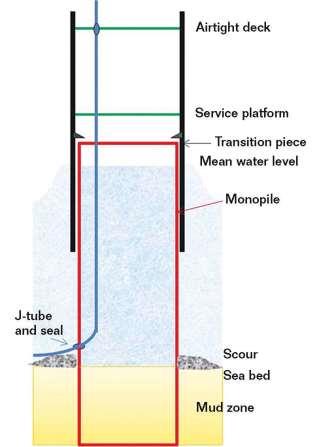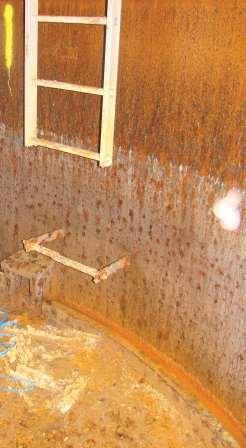Over the last decade, offshore wind power has gone from a marginal industry to a major government-supported renewable energy source in Northern Europe. An increasing number of wind turbine structures have been installed, particularly on monopile foundations. This type of foundation is currently the most common type used due to its ease of installation in shallow to medium water depths (up to 30 m deep). NACE International members Anders Rosborg Black, Lisbeth Rischel Hilbert, and Troels Mathiesen with FORCE Technology (Brøndby, Denmark), in their CORROSION 2015 paper, “Corrosion Protection of Offshore Wind Foundations,” review corrosion experiences reported by the offshore wind energy industry for monopile foundations and discuss corrosion mitigation strategies.
 A monopile wind turbine foundation consists of a steel pile driven into the seabed with 1 to 2 m of the pile structure above the water line. A transition piece is installed over the top of the monopile with an overlap of ~6 m, and a number of brackets inside the transition piece are designed to aid in its adjustment. The annular space between the monopile and the transition piece is then filled with high-strength grout that cements the two pipes together. Figure 1 shows a schematic drawing of an early monopile foundation design with a transition piece and an internal J-tube, which is used to house the turbine’s electrical connection cable. Today, other designs with a conical interface or a flange connection are becoming more common.
A monopile wind turbine foundation consists of a steel pile driven into the seabed with 1 to 2 m of the pile structure above the water line. A transition piece is installed over the top of the monopile with an overlap of ~6 m, and a number of brackets inside the transition piece are designed to aid in its adjustment. The annular space between the monopile and the transition piece is then filled with high-strength grout that cements the two pipes together. Figure 1 shows a schematic drawing of an early monopile foundation design with a transition piece and an internal J-tube, which is used to house the turbine’s electrical connection cable. Today, other designs with a conical interface or a flange connection are becoming more common.
The authors comment that both external and internal corrosion issues have affected monopile foundation structures. External corrosion of the foundation is similar to that observed in other offshore industries, and corrosion protection is prescribed in current industry guidelines based on experiences from the oil and gas industry. Cathodic protection (CP) of offshore structures with galvanic anodes is a well-established corrosion prevention technique, and DNV-RP-B4011 provides requirements and guidelines for CP design, anode manufacturing, and installation of galvanic anodes. The design of an impressed current CP (ICCP) system is described in DNV-OS-J101,2 NACE SP0176,3 and BS EN 12495.4 Coating use is mandatory in the atmospheric and splash zones. External surfaces of the submerged zone have CP; and in the splash zone, CP may be assumed to be fully protective below the mean water level. In most projects, the CP system uses galvanic anodes placed on the transition piece, but ICCP systems are being applied in an increasing number of projects. A protective coating applied in the submerged zone is optional and primarily intended to reduce the level of CP required. General recommendations for coating systems to be used offshore are given in international standards such as EN ISO 12944,5 ISO 20340,6 and NORSOK M-501.7
Presently, the authors note, precise guidelines for internal corrosion protection of monopile wind turbine foundations are not provided in current industry standards, and the corrosion protection strategy for the internal surfaces is up to the individual owners or designers. In early projects, additional material thickness for corrosion allowance was used as corrosion protection for the internal surfaces. The monopile foundation’s closed-compartment design was assumed to be completely air- and watertight, and low, uniform corrosion rates were anticipated. In a completely airtight structure, the dissolved oxygen (DO) in seawater would be quickly consumed by uniform corrosion on the entire steel surface, and corrosion rates would decrease as the seawater became anaerobic.
 Industry experience has shown, however, that it is difficult in practice to completely seal compartments and render them airtight. If the closed-compartment structure is not properly sealed, direct ingress of air is possible. Seawater and oxygen ingress have been detected in foundations that are two to 10 years old, which increased the rate of corrosion and localized corrosion attacks. Furthermore, in some cases, the increasing water level has led to the internal aluminum ladder acting as a sacrificial anode (Figure 2).
Industry experience has shown, however, that it is difficult in practice to completely seal compartments and render them airtight. If the closed-compartment structure is not properly sealed, direct ingress of air is possible. Seawater and oxygen ingress have been detected in foundations that are two to 10 years old, which increased the rate of corrosion and localized corrosion attacks. Furthermore, in some cases, the increasing water level has led to the internal aluminum ladder acting as a sacrificial anode (Figure 2).
These unexpected contradictions to design expectations were discovered during inspections and surveys related to grout failures that caused the settling of the transition piece on the monopile in a large number of northern European wind farms. In the case of oxygen ingress, the corrosion rate in the atmospheric zone initially may be high, but it will decrease in time. Below the water line, corrosion is caused by aeration differences between the upper layer of water and the active steel surface beneath. If the water level is completely stagnant, corrosion will be highly localized with limited coverage, so widespread corrosion is not expected at greater depths in the foundation or on the portion of the structure buried in sediment.
There is also a risk of microbiologically influenced corrosion (MIC) in a closed-compartment foundation—with localized corrosion attacks on the submerged surface and in the portions of the monopile buried in the upper region of the sediment. Alternating aerobic and anaerobic conditions may also favor bacteria growth, and the risk of MIC depends on the bacteria species and the environmental conditions present. Sulfate-reducing bacteria (SRB) are expected to be present, and if growth conditions are favorable, then sulfide production can occur.
The oxygen content in the interior of the foundation may also change due to slow seawater ingress through minor leaks at the J-tube seal, degraded grout connections, or small J-tube openings/perforations. When seawater with DO enters the system, corrosion over the entire surface is increased. In the air-depleted mud zone, however, there is a higher risk of accelerated corrosion, mainly due to aeration differentials. Additionally, the seawater renewal will affect the microbiological and chemical processes inside the compartment. If the ingress of seawater is substantial (e.g. if the J-tube seal has fully failed), tidal variations may occur directly inside the foundation and the water level may change daily or during extreme events. In this case, the foundation’s interior resembles the conditions of a sea port with fairly stagnant water and tidal effects, or a ballast tank where air access is restricted.
Based on these experiences, recent wind turbine foundation projects have included coatings and/or CP as part of the internal corrosion protection. Several wind farm owners have decided to retrofit existing monopile structures with internal galvanic CP systems as well as include internal CP as part of the design for new projects. To assess actual corrosion conditions for determining appropriate corrosion prevention strategies and to check on the effect of current mitigation efforts, several wind farm owners have also installed monitoring systems within offshore monopile foundations. These monitoring systems provide data on corrosive conditions that help to increase the level of understanding of conditions inside the foundations. According to the authors, monitoring critical parameters and/or corrosion rates may be carried out by accumulation methods such as coupons, or real-time techniques that use probes. Measured parameters could include DO, temperature, salinity, pH values, and potentials, with measurements taken either manually or by an automated system.
Although internal CP is currently being implemented in many wind farms, the authors note that there may be some challenges with these CP systems, such as reduction in pH values, incomplete formation of calcareous scale, formation of hydrogen gas, or the accumulation of hydrogen sulfide (H2S). Additionally, an internal CP retrofit is costly and difficult since the work must be carried out in a confined space and the system design most likely must be determined on a case-by-case basis as foundation designs and conditions vary among wind farms.
The interior surfaces of most monopile foundation structures generally have been left uncoated based on the belief that corrosion rates would be negligible. Since ingress of seawater and air may occur in the foundations and instigate more corrosion on the internal surfaces than expected, more focus has been put on protecting the internal areas of the foundations with a coating. In some cases, 3 to 4 m of the internal surface of the transition piece is coated in the area where the predominant water level is expected to be located. Inside the monopile, closed areas that are not airtight may be coated with two 200- to 250-µm coats of epoxy coating. Coating systems based on epoxy zinc dust primers also may be applicable.
The authors comment that further investigation on the effects of localized corrosion of monopile wind turbine foundations is needed. Although DNV-OS-J101 calls for a grade of steel to be used that will mitigate the risk of pitting damage, literature data and reported experiences demonstrate that the construction steel commonly used for offshore structures is prone to pitting corrosion in seawater and marine environments. Using construction materials such as highly alloyed stainless steels that are resistant to pitting corrosion may not be economically feasible. Since pits may initiate stress and fatigue cracks, however, the degree of pitting corrosion, its position, and the concentration that can be tolerated on a wind farm structure without compromising its structural integrity should be determined. The risk of localized corrosion in the mud zone should also be examined further, since mudline corrosion may be significant for structures designed for long service lives.
Another area that merits more investigation is monitoring the impact of installed CP, since the various guidelines presented in the standards do not give a precise description or method for designing a CP system for the interior of a monopile or a transition piece. Additionally, fatigue life and the risk of stress-oriented, hydrogen-induced cracking (SOHIC) may be issues to consider when implementing internal CP. According to DNV-OS-J101, the susceptibility of steel to SOHIC should be considered when it’s used for critical applications, particularly in anaerobic environmental conditions where stagnant water, organically active mud (bacteria), and H2S are present. The risk of SOHIC may not be high for steel presently used in construction, but if more high-strength steel types are used in the future, the risk of SOHIC may increase.
For more information, contact Anders Rosborg Black, FORCE Technology—e-mail: ack@force.dk.
References
1 DNV-RP-B401, “Cathodic protection design” (Høvik, Norway: DNV GL, 2010).
2 DNV-OS-J101, “Design of offshore wind turbine structures” (Høvik, Norway: DNV GL, 2013).
3 SP0176-2007 (formerly RP0176), “Corrosion Control of Submerged Areas of Permanently Installed Steel Offshore Structures Associated with Petroleum Production” (Houston, TX: NACE International, 2007).
4 BS EN 12495:2000, “Cathodic protection for fixed steel offshore structures” (London, U.K.: BSI, 2000).
5 EN ISO 12944-5:2007, “Corrosion protection of steel structures by protective paint systems” (Geneva, Switzerland: ISO, 2007).
6 ISO 20340:2009, “Paints and varnishes—Performance requirements for protective paint systems for offshore and related structures” (Geneva, Switzerland: ISO, 2009).
7 NORSOK M-501, “Surface preparation and protective coating” (Lysaker, Norway: NORSOK, 2012).